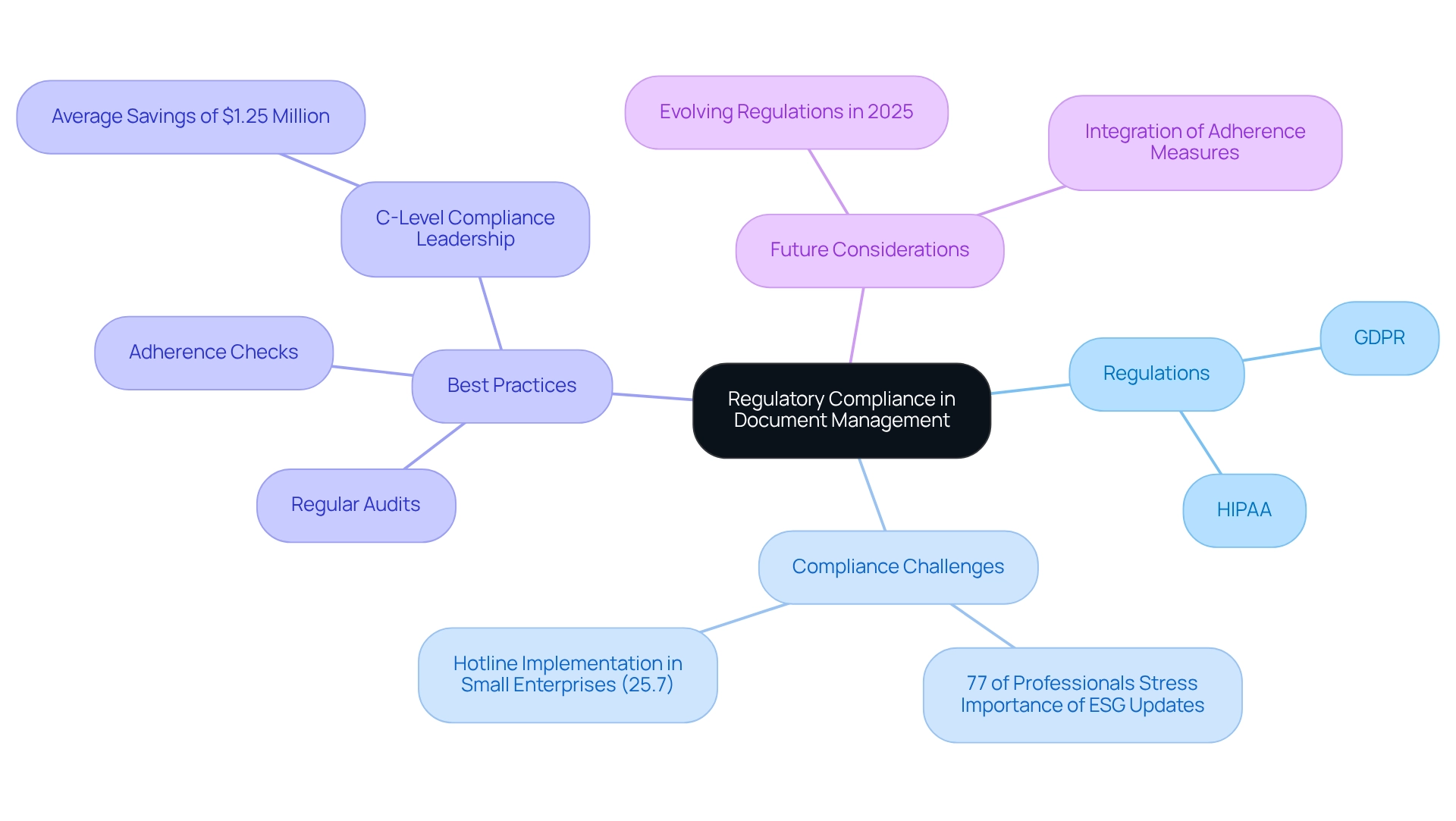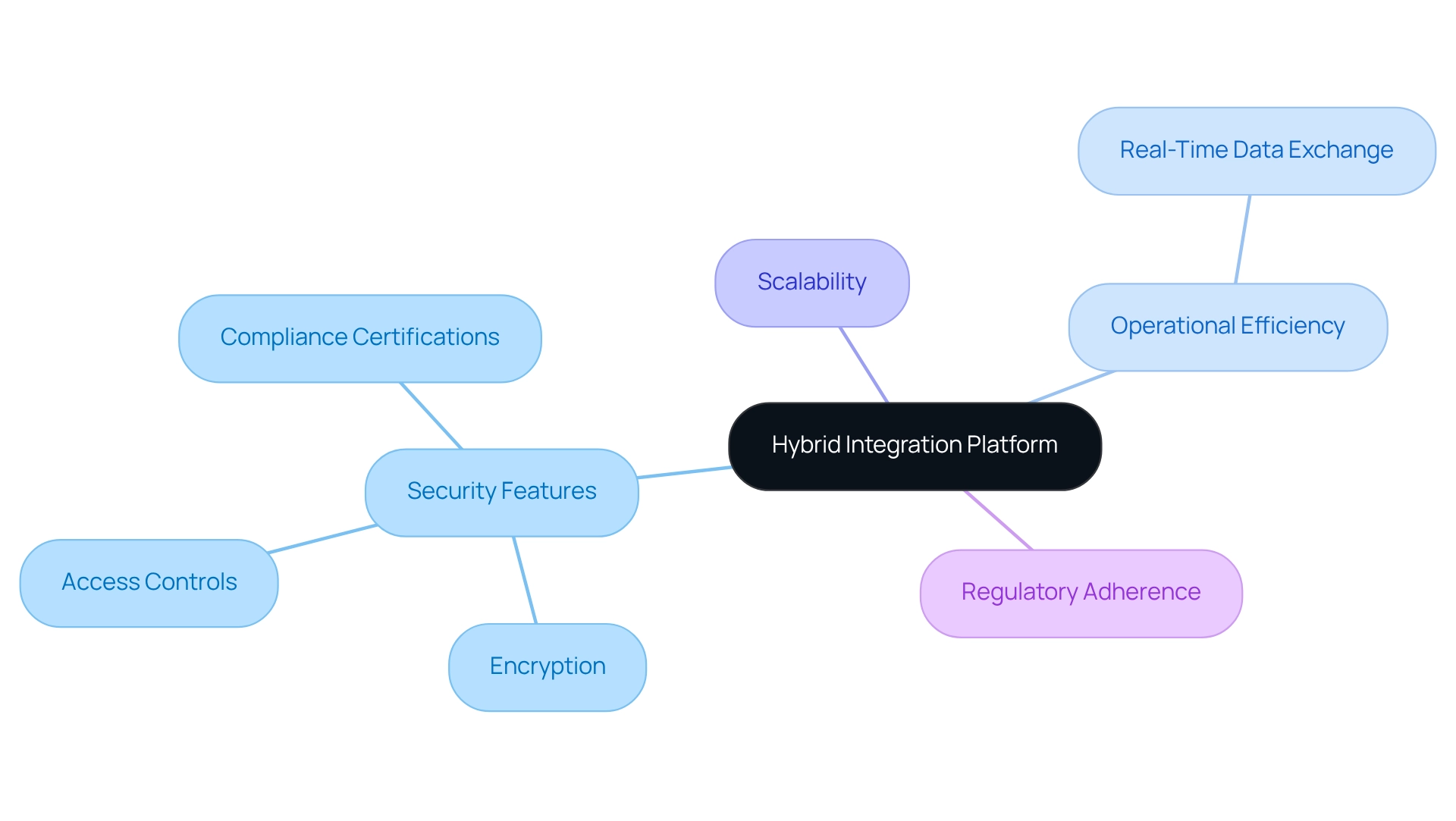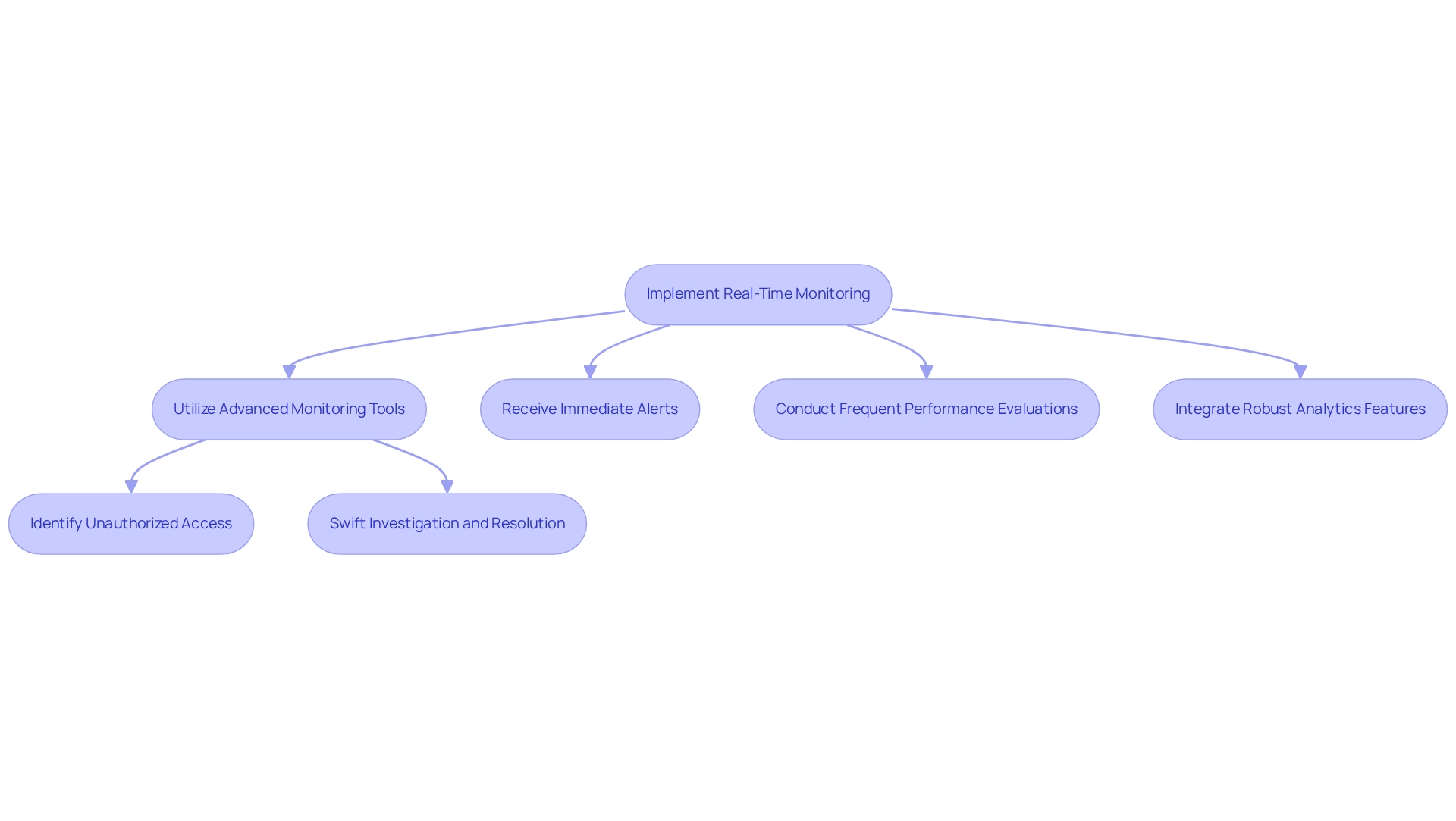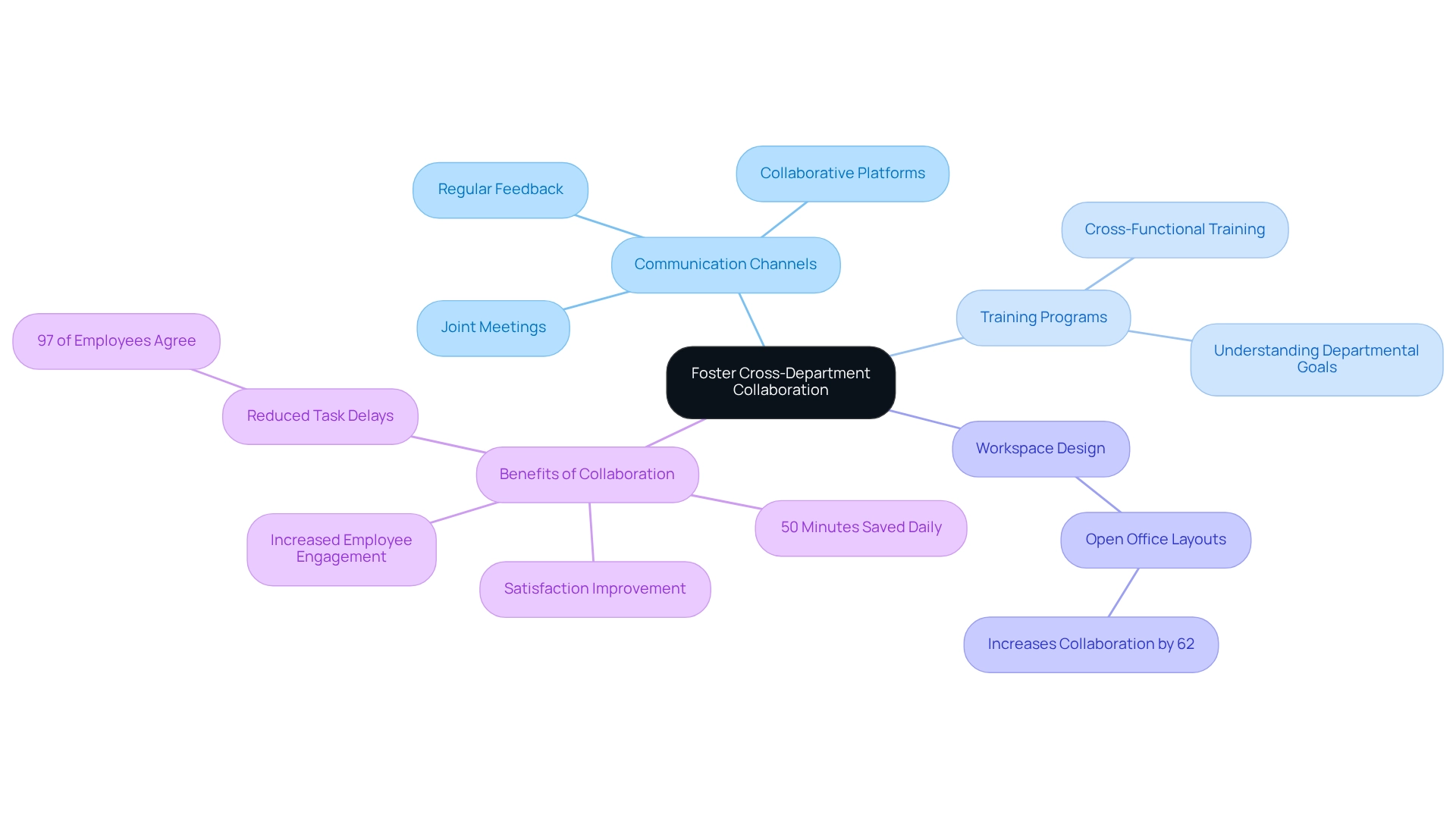Overview
We recognize that effective integration document management hinges on four essential practices:
- Regulatory compliance
- Hybrid integration platforms
- Real-time monitoring
- Cross-department collaboration
These elements are not merely suggestions; they are critical to safeguarding sensitive information and enhancing operational efficiency. For instance, adherence to regulations such as GDPR and HIPAA is vital. What’s holding your team back from achieving compliance? By fostering collaboration and implementing real-time monitoring, we can align IT and business goals, ultimately driving success. Embrace these practices to not only meet regulatory demands but also to elevate your organization’s performance.
Introduction
In an age where data management and regulatory compliance are paramount, we must navigate a labyrinth of laws and standards to protect sensitive information. With regulations like GDPR and HIPAA shaping the landscape, understanding the intricacies of document management integration becomes crucial for our success. As we grapple with compliance challenges and the need for robust security measures, the integration of advanced monitoring tools and cross-department collaboration emerges as a strategic imperative.
This article delves into the essential practices that we can adopt to enhance our document management systems, safeguard our operations, and align IT and business goals in a rapidly evolving regulatory environment.
Understand Regulatory Compliance in Document Management Integration
Navigating the complex landscape of data handling and storage legislation requires strict adherence to regulations in integration document management. We recognize that familiarity with frameworks such as GDPR and HIPAA is crucial; these regulations dictate the management of sensitive information. For instance, healthcare providers must implement stringent measures for data retention, access control, and audit trails, ensuring that patient records are securely stored and accessible only to authorized personnel.
Recent statistics reveal that a significant portion of organizations encounter challenges with compliance; indeed, 77% of corporate risk and adherence specialists underscore the importance of staying informed on ESG advancements, reflecting a broader trend towards regulatory awareness. Additionally, two-thirds of these professionals believe their companies bear a responsibility to address ESG-related issues, with 61% highlighting the need for regulatory updates. Notably, in small enterprises, hotlines are established in only 25.7% of cases examined, pinpointing an area where adherence efforts may be insufficient.
To mitigate risks associated with non-compliance, we advocate for regular audits and adherence checks. These practices not only help identify gaps in processes but also enhance our reputation among clients and stakeholders. By prioritizing compliance with regulations, we can protect ourselves from potential legal penalties while fostering trust and credibility in our operations. Appointing a C-level leader for adherence can yield substantial financial benefits, with companies saving an average of $1.25 million in regulatory expenses, underscoring the importance of effective leadership in this domain.
As we adapt to evolving regulations in 2025, integrating adherence measures into our record-keeping practices will remain a vital component of our strategic framework. Instances of organizations successfully implementing GDPR and HIPAA in their document handling systems provide valuable insights for banking IT managers, illustrating best practices and common pitfalls to avoid in their integration document efforts.

Choose a Hybrid Integration Platform for Enhanced Security and Efficiency
When it comes to selecting a hybrid integration platform, we must prioritize essential security features, as specified in the integration document, such as encryption, access controls, and compliance certifications. Our robust hybrid integration platform is designed to serve as an integration document that facilitates seamless integration between legacy systems and modern applications, ensuring efficient data flow and process automation.
For instance, consider a banking institution that implements our platform to support real-time data exchange between its core banking system and customer relationship management (CRM) software. This approach not only enhances operational efficiency but also safeguards sensitive customer information throughout the integration document process. Furthermore, with 72% of security experts identifying underlying infrastructure compromise as a significant concern, it is crucial to choose platforms like ours that offer comprehensive security strategies to mitigate these risks. The recent leak of 1.5 billion records by the Real Estate Wealth Network starkly illustrates the dire consequences of inadequate security measures, underscoring the necessity for robust integration solutions.
Scalability is another vital consideration; our platform is designed to adapt to future growth and evolving business needs. As 37% of entities emphasize regulatory adherence in their cloud security initiatives, it is essential to refer to an integration document that demonstrates how our platform meets these criteria for maintaining a competitive advantage in the banking industry. We invite you to explore how our hybrid integration platform can empower your organization to thrive in an increasingly complex landscape.

Implement Real-Time Monitoring for System Performance and Compliance
Establishing real-time monitoring is paramount for organizations like ours that seek to consistently track the performance of information management processes and ensure adherence to regulatory requirements. By utilizing advanced monitoring tools, we can receive immediate alerts for anomalies or potential compliance breaches. For instance, a financial organization may employ a monitoring system that identifies unauthorized access attempts to sensitive files, enabling swift investigation and resolution.
Furthermore, ensuring that our integration document provides robust analytics features is vital for enhancing operations and boosting customer experiences. Frequent performance evaluations are essential, as they assist in recognizing bottlenecks in workflow processes, enabling us to improve overall efficiency. In 2025, the significance of real-time monitoring in document management systems, particularly for the integration document that outlines how 73% of businesses have adopted a hybrid cloud approach by integrating public or private cloud solutions with on-premise systems, cannot be overstated. This shift necessitates strong monitoring tools to effectively manage the complexities of hybrid environments.
Moreover, 67% of global executives believe ESG regulation is too complex, underscoring the challenges organizations face in maintaining compliance. The financial repercussions of regulatory breaches are substantial, with the worldwide average cost of stolen records rising to USD 169, and employee PII being the most expensive at USD 189 per record. Industry leaders advocate for a proactive oversight strategy, which not only guarantees the seamless functioning of record handling systems but also upholds adherence to evolving industry regulations. By employing real-time monitoring tools, we can significantly enhance our compliance and operational capabilities, ultimately fostering a culture of accountability and transparency.
In addition, the shift towards mobile file handling solutions, expected to encompass all business file access by 2027, highlights the necessity for real-time monitoring in a mobile environment. The increasing focus on ESG compliance reflects a broader societal expectation for organizations to address environmental and social governance concerns, making it essential for financial institutions like ours to implement comprehensive monitoring strategies.

Foster Cross-Department Collaboration to Align IT and Business Goals
Encouraging inter-departmental cooperation is essential for aligning our IT and business objectives, particularly in information handling. We must establish regular communication channels, such as joint meetings and collaborative platforms, to facilitate information sharing and feedback. Notably, research indicates that employees feel a third of their weekly meetings are unnecessary, underscoring the need for effective meeting structures to enhance collaboration. For instance, a healthcare organization may bring together our IT personnel and clinical teams to discuss the requirements for a new file handling system, ensuring that the solution meets both technical specifications and operational needs.
Implementing cross-functional training programs can further improve our understanding of each department’s challenges and goals, fostering a culture of collaboration. Research shows that higher collaboration levels lead to increased employee engagement and satisfaction, which are crucial for successful integration initiatives. Moreover, statistics reveal that 97% of employees believe misalignment in teams negatively impacts task outcomes, resulting in delays and reduced effectiveness. By prioritizing collaboration, we can ensure our document management systems, including the integration document, are not only technically robust but also strategically aligned with our organizational goals. Additionally, a study by McKinsey suggests that employees save an average of 50 minutes daily due to streamlined communication, highlighting the time-saving benefits of efficient collaboration. Furthermore, open office layouts can increase collaboration by up to 62%, indicating that workspace design significantly influences teamwork dynamics. By implementing these strategies, we can streamline processes and foster a more agile and responsive environment, ultimately enhancing our operational capabilities and driving innovation.

Conclusion
Navigating regulatory compliance in document management is not just crucial; it is imperative for organizations like ours that aim to protect sensitive information and uphold operational integrity. Understanding frameworks such as GDPR and HIPAA is essential—not merely for legal adherence but for enhancing our reputation and credibility. By prioritizing compliance through regular audits and dedicated leadership, we can mitigate risks and realize substantial financial benefits.
Choosing a robust hybrid integration platform, such as Avato’s, is key to achieving security and efficiency. These platforms empower us to leverage existing systems while ensuring real-time data exchange and comprehensive security measures. As the landscape of data management evolves, investing in scalable solutions that meet compliance requirements is vital for maintaining our competitive edge.
Furthermore, the implementation of real-time monitoring tools is essential for tracking performance and compliance. These tools enable us to identify potential breaches promptly and optimize workflows, fostering accountability and transparency—especially in hybrid cloud environments where compliance challenges are heightened.
Finally, fostering cross-department collaboration is critical for aligning our IT and business objectives. Effective communication and understanding between teams lead to document management systems that are both technically robust and strategically aligned with our organizational goals. This collaboration enhances operational efficiency and drives innovation.
In summary, as we adapt to an evolving regulatory landscape, integrating compliance practices, advanced technologies, and collaborative efforts will be pivotal. Embracing these strategies will not only safeguard sensitive information but also empower us to thrive amidst the complexities of modern data management.

